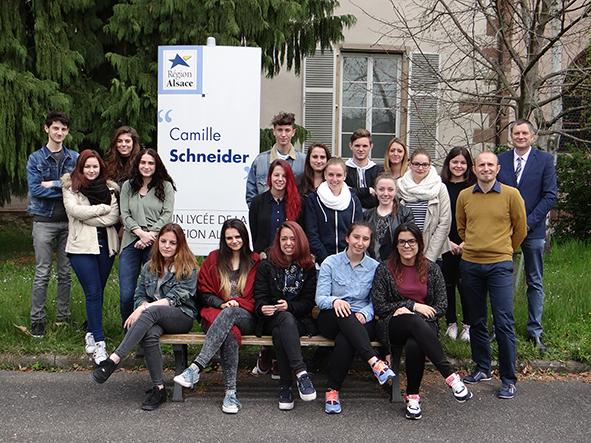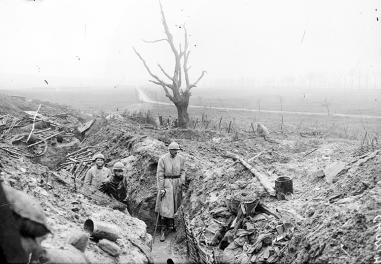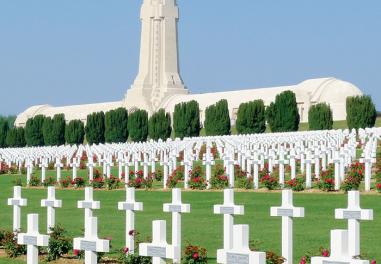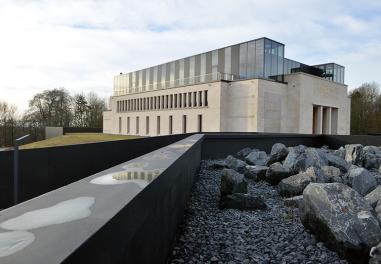Some pupils at Verdun
After studying the work of Maurice Genevoix, final year secondary school pupils from the Camille Schneider vocational lycée in Molsheim visited Verdun and the Éparges site where the author of Ceux de 14 (The Men of 1014) fought.
Confrontation with the living memory of the site.

Can you tell us about the different stages in your project? How was the work organised?
The project began two years ago, in "seconde" year. It was our French and history-geography teacher, Mr Dargent, who proposed we do this as part of the commemoration of the centenary of the Great War. We liked the idea of the project, especially since we didn't know much about the First World War. We knew that at home in Alsace there had been very heavy fighting in the Vosges mountains and that after the war our region returned to being part of France.
In the first year, we did an exhibition entitled "Writings and writers of the Great War", a work for which we read several texts by soldier writers, testimonies of "poilus" soldiers but also novels about the war by more recent authors. We also visited Fort Mutzig, a very impressive defence structure built after the 1870 war by the Germans and located ten kilometres from our school. And this year we visited Éparges, Douaumont and the newly renovated Verdun Memorial sites.
How did you choose to work on writers and the Great War?
In the final year history syllabus, we had to study the theme "Europe, a land of conflicts" and in French we had to study "In the 20th century, man and his relationship to the world through literature and the other arts". The visit to Verdun and the study of the work of Maurice Genevoix, Ceux de 14 - Les Eparges, could therefore be part of the syllabuses. And this also fit into moral and civic education or the new civic journey that includes defence education.
During our research, we discovered that much had been written about this conflict and that many famous writers had taken part so this gave us the idea for an exhibition.
What dis you get out of this experience and has it changed your outlook on the war?
We realised how lucky we were to live in peacetime: our ancestors had to make such sacrifices and experienced so much suffering. Peace and understanding between peoples must be maintained at all cost. In our region, our grandparents or great-grandparents suffered enormously from the conflicts between France and Germany. Remembering all that is very important. We were surprised by how violent the fighting was.
Discovering shell holes a century later and the land still totally ravaged, as along the paths on the Eparges site or near the Froideterre structure in Verdun or the destroyed village of Fleury, or the 16,000 tombs lined up in front of the Douaumont ossuary, was all very concrete and real. It is much more impressive than any film on the subject or on the war in general.
Among the texts you studied, which moved you most? Why?
The story by Maurice Genevoix or Wooden Crosses by Roland Dorgelès are very moving, but even more so are the letters from the soldiers. We see what their daily lives were like and especially the horror of war. For example in this letter from Jules Gillet to his wife on 19 May 1915, saying how the war is violent and inhuman: "It's terrible to see my comrades chopped up, I'm all covered with blood. Camille is beside me shooting non-stop as are the others who are left standing. When all of a sudden, my dear Louise, I got the greatest shock, my brother fell back into my arms. He just took a bullet to the head and you know they are not very forgiving... He died vomiting blood from his mouth, nose and ears [...] Mad with despair, not knowing what to do, I started to dig a hole behind the trench and I buried him there with my small cross... If ever I come back, I'll know where to find him but, alas, we are destined to end like this, my poor wife, and I will never see you again."
Read more
Bibliography
Bassoles s'en va-t'en guerre, under the direction of Nicole Buresi, Chèvre Feuille Etoilée, 2015
Remembrance sites
Articles of the review
-
The file

Verdun 1916-2016
The Battle of Verdun is the epitome of the 1914-1918 war for the French in all its intensity and horror, but it also became "The" battle, a symbol of resistance and victory with Verdun then becoming the venue for Franco-German reconciliation. Antoine Prost and Gerd Krumeich compare their analyses he...Read more -
The event

Verdun, a site of Franco-German remembrance
Read more -
The figure

The Verdun Memorial
Created in 1967, the Verdun Memorial is a key historical and remembrance site set in the heart of the battlefield.
After a complete overhaul and extension, the Memorial reopened on 21 February, the anniversary of the first day of the battle of Verdun.
Read more

